Digital Transformation: Strategies, Technologies, and Business Impact
VerifiedAdded on 2023/06/18
|9
|2751
|423
Report
AI Summary
This report provides a detailed analysis of digital transformation, emphasizing its importance, development stages, and the technologies involved. It covers mobile applications, cloud computing, IoT, digital twins, and AI, along with collaborative suites, communication tools, and intranet platforms. The report examines how various businesses utilize digital transformation as a business tool for promotion and security, linking these practices to business theories like the Principles of Administrative Management. It highlights the significance of organization, command, control, coordination, planning, and forecasting in achieving successful digital transformation and concludes with the necessity for companies to adopt digital strategies to remain competitive in the evolving market.
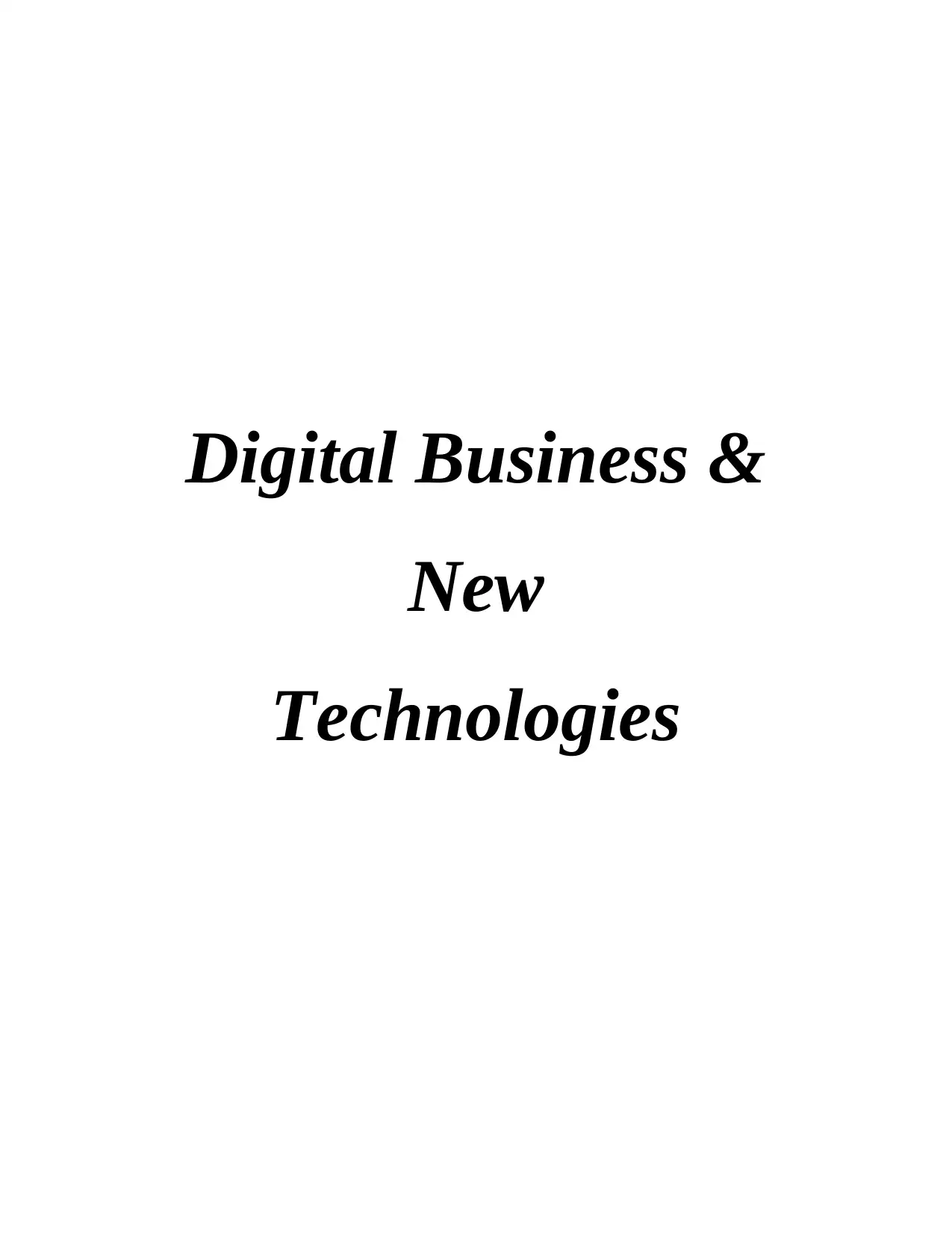
Digital Business &
New
Technologies
New
Technologies
Paraphrase This Document
Need a fresh take? Get an instant paraphrase of this document with our AI Paraphraser
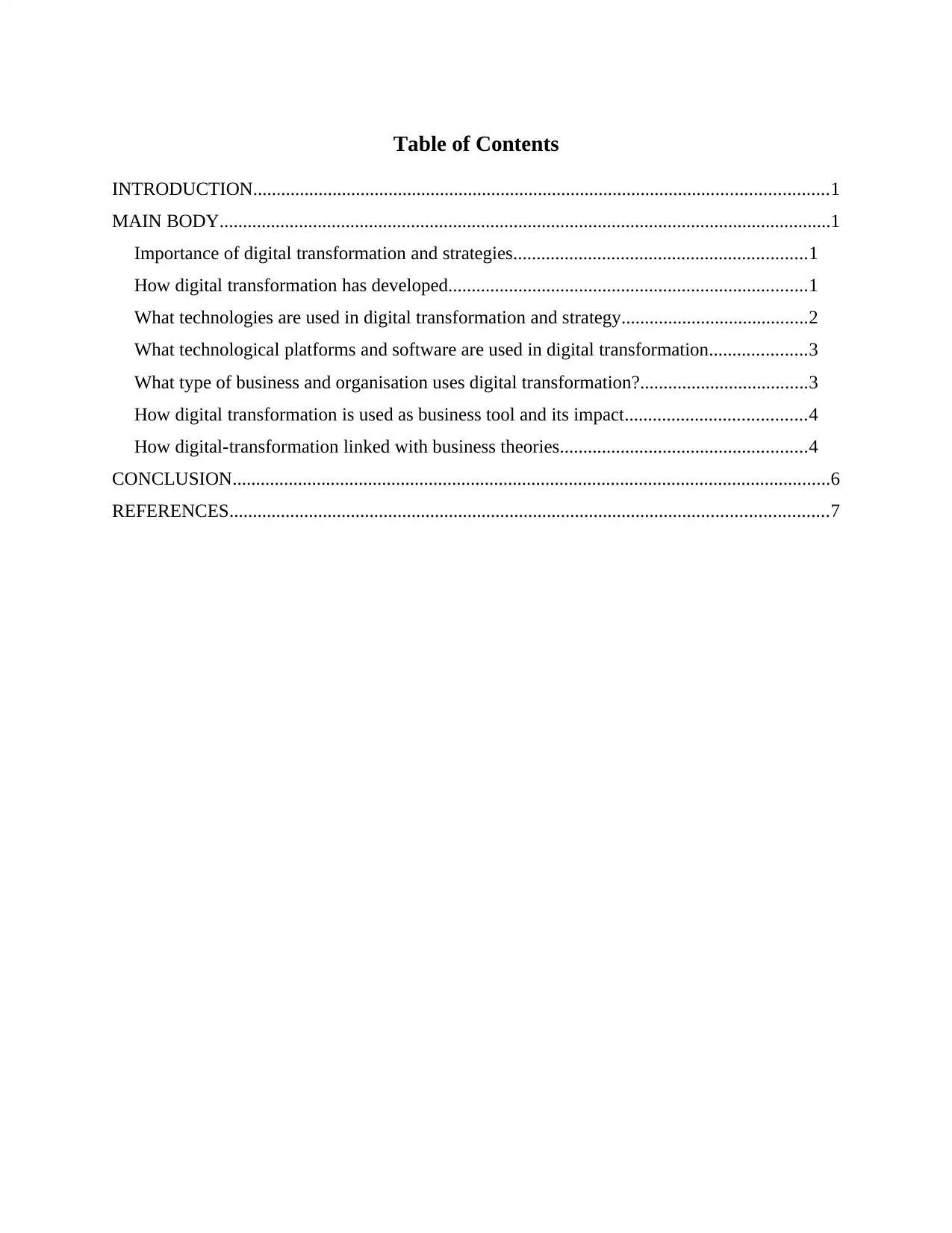
Table of Contents
INTRODUCTION...........................................................................................................................1
MAIN BODY...................................................................................................................................1
Importance of digital transformation and strategies...............................................................1
How digital transformation has developed.............................................................................1
What technologies are used in digital transformation and strategy........................................2
What technological platforms and software are used in digital transformation.....................3
What type of business and organisation uses digital transformation?....................................3
How digital transformation is used as business tool and its impact.......................................4
How digital-transformation linked with business theories.....................................................4
CONCLUSION................................................................................................................................6
REFERENCES................................................................................................................................7
INTRODUCTION...........................................................................................................................1
MAIN BODY...................................................................................................................................1
Importance of digital transformation and strategies...............................................................1
How digital transformation has developed.............................................................................1
What technologies are used in digital transformation and strategy........................................2
What technological platforms and software are used in digital transformation.....................3
What type of business and organisation uses digital transformation?....................................3
How digital transformation is used as business tool and its impact.......................................4
How digital-transformation linked with business theories.....................................................4
CONCLUSION................................................................................................................................6
REFERENCES................................................................................................................................7
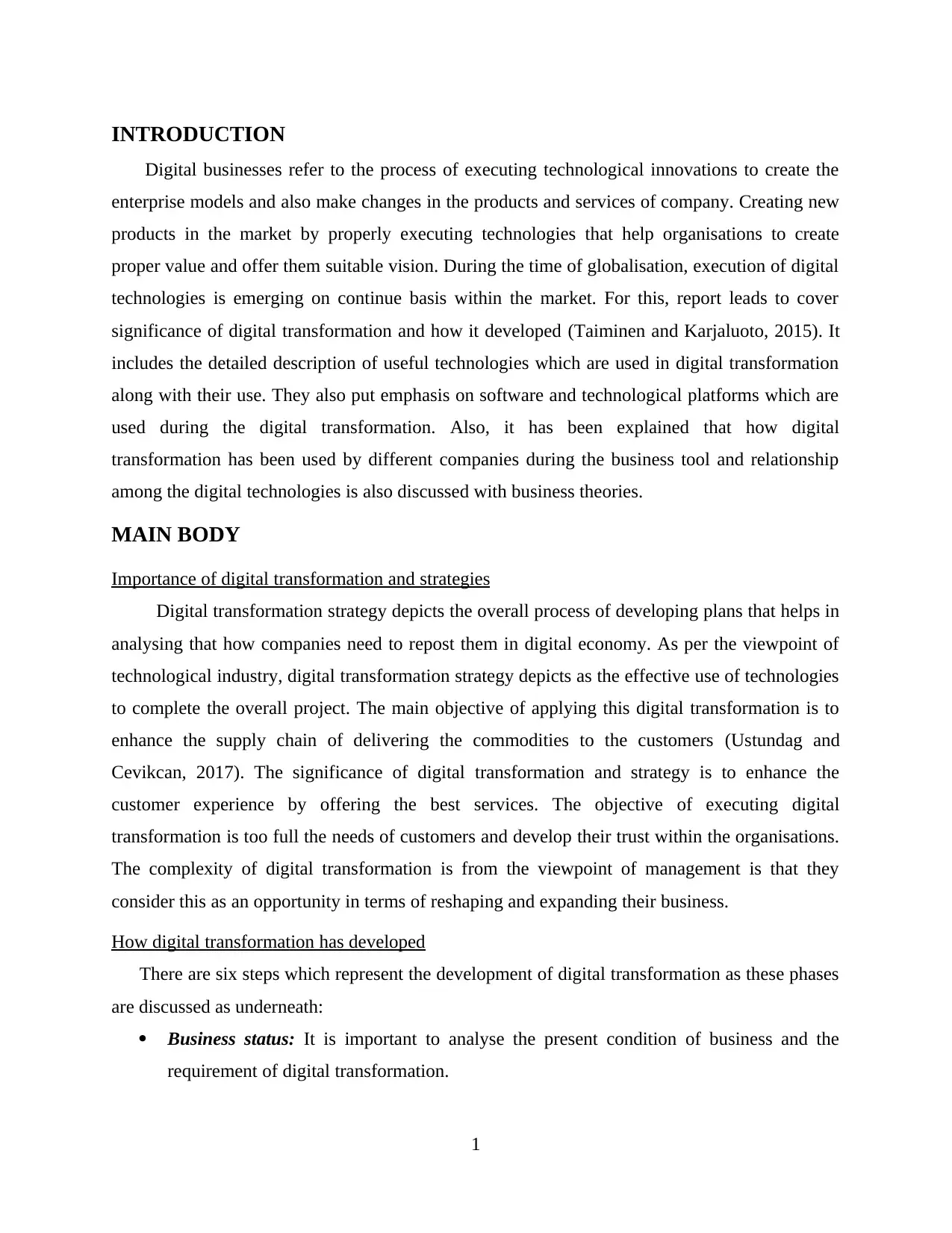
INTRODUCTION
Digital businesses refer to the process of executing technological innovations to create the
enterprise models and also make changes in the products and services of company. Creating new
products in the market by properly executing technologies that help organisations to create
proper value and offer them suitable vision. During the time of globalisation, execution of digital
technologies is emerging on continue basis within the market. For this, report leads to cover
significance of digital transformation and how it developed (Taiminen and Karjaluoto, 2015). It
includes the detailed description of useful technologies which are used in digital transformation
along with their use. They also put emphasis on software and technological platforms which are
used during the digital transformation. Also, it has been explained that how digital
transformation has been used by different companies during the business tool and relationship
among the digital technologies is also discussed with business theories.
MAIN BODY
Importance of digital transformation and strategies
Digital transformation strategy depicts the overall process of developing plans that helps in
analysing that how companies need to repost them in digital economy. As per the viewpoint of
technological industry, digital transformation strategy depicts as the effective use of technologies
to complete the overall project. The main objective of applying this digital transformation is to
enhance the supply chain of delivering the commodities to the customers (Ustundag and
Cevikcan, 2017). The significance of digital transformation and strategy is to enhance the
customer experience by offering the best services. The objective of executing digital
transformation is too full the needs of customers and develop their trust within the organisations.
The complexity of digital transformation is from the viewpoint of management is that they
consider this as an opportunity in terms of reshaping and expanding their business.
How digital transformation has developed
There are six steps which represent the development of digital transformation as these phases
are discussed as underneath:
Business status: It is important to analyse the present condition of business and the
requirement of digital transformation.
1
Digital businesses refer to the process of executing technological innovations to create the
enterprise models and also make changes in the products and services of company. Creating new
products in the market by properly executing technologies that help organisations to create
proper value and offer them suitable vision. During the time of globalisation, execution of digital
technologies is emerging on continue basis within the market. For this, report leads to cover
significance of digital transformation and how it developed (Taiminen and Karjaluoto, 2015). It
includes the detailed description of useful technologies which are used in digital transformation
along with their use. They also put emphasis on software and technological platforms which are
used during the digital transformation. Also, it has been explained that how digital
transformation has been used by different companies during the business tool and relationship
among the digital technologies is also discussed with business theories.
MAIN BODY
Importance of digital transformation and strategies
Digital transformation strategy depicts the overall process of developing plans that helps in
analysing that how companies need to repost them in digital economy. As per the viewpoint of
technological industry, digital transformation strategy depicts as the effective use of technologies
to complete the overall project. The main objective of applying this digital transformation is to
enhance the supply chain of delivering the commodities to the customers (Ustundag and
Cevikcan, 2017). The significance of digital transformation and strategy is to enhance the
customer experience by offering the best services. The objective of executing digital
transformation is too full the needs of customers and develop their trust within the organisations.
The complexity of digital transformation is from the viewpoint of management is that they
consider this as an opportunity in terms of reshaping and expanding their business.
How digital transformation has developed
There are six steps which represent the development of digital transformation as these phases
are discussed as underneath:
Business status: It is important to analyse the present condition of business and the
requirement of digital transformation.
1
⊘ This is a preview!⊘
Do you want full access?
Subscribe today to unlock all pages.

Trusted by 1+ million students worldwide
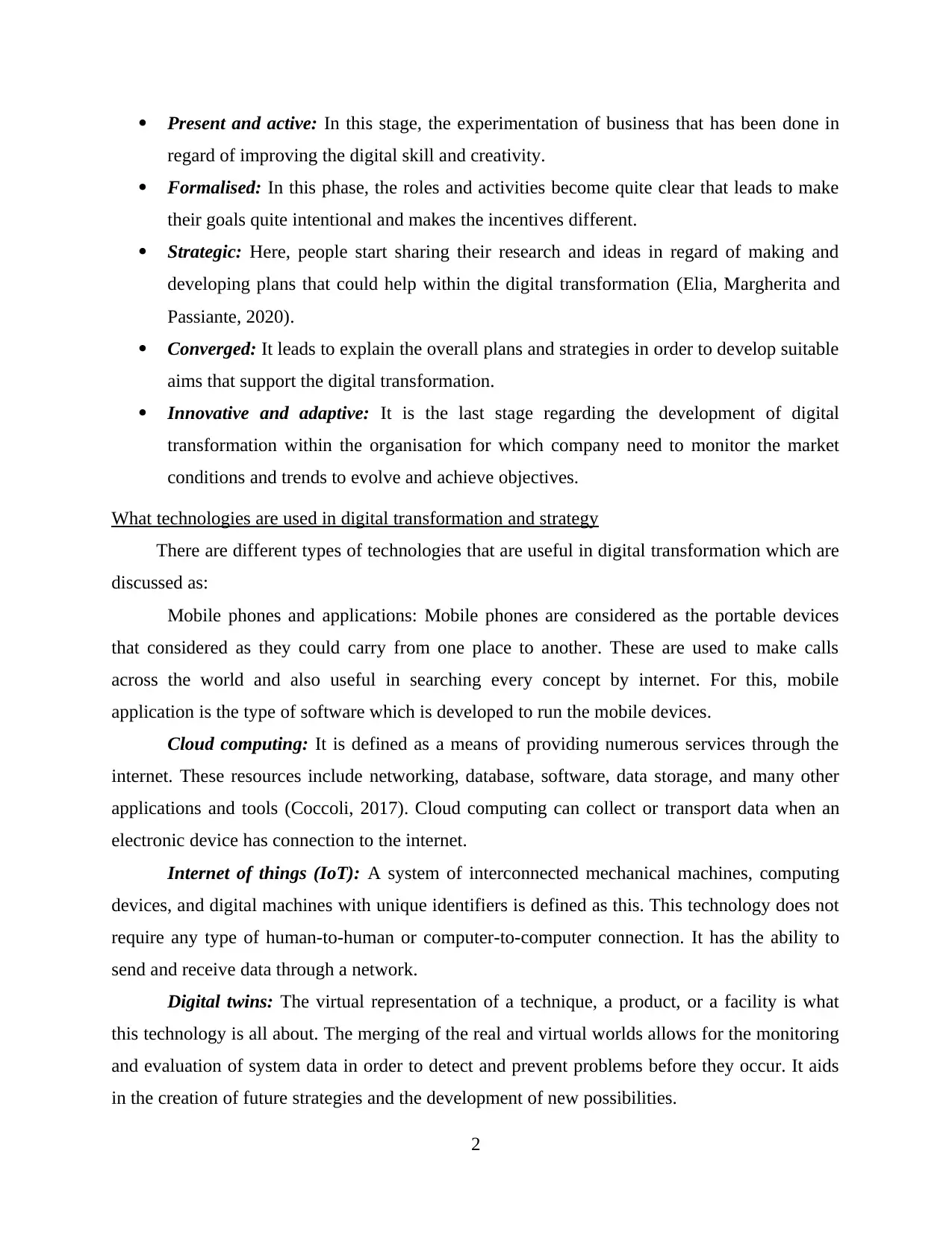
Present and active: In this stage, the experimentation of business that has been done in
regard of improving the digital skill and creativity.
Formalised: In this phase, the roles and activities become quite clear that leads to make
their goals quite intentional and makes the incentives different.
Strategic: Here, people start sharing their research and ideas in regard of making and
developing plans that could help within the digital transformation (Elia, Margherita and
Passiante, 2020).
Converged: It leads to explain the overall plans and strategies in order to develop suitable
aims that support the digital transformation.
Innovative and adaptive: It is the last stage regarding the development of digital
transformation within the organisation for which company need to monitor the market
conditions and trends to evolve and achieve objectives.
What technologies are used in digital transformation and strategy
There are different types of technologies that are useful in digital transformation which are
discussed as:
Mobile phones and applications: Mobile phones are considered as the portable devices
that considered as they could carry from one place to another. These are used to make calls
across the world and also useful in searching every concept by internet. For this, mobile
application is the type of software which is developed to run the mobile devices.
Cloud computing: It is defined as a means of providing numerous services through the
internet. These resources include networking, database, software, data storage, and many other
applications and tools (Coccoli, 2017). Cloud computing can collect or transport data when an
electronic device has connection to the internet.
Internet of things (IoT): A system of interconnected mechanical machines, computing
devices, and digital machines with unique identifiers is defined as this. This technology does not
require any type of human-to-human or computer-to-computer connection. It has the ability to
send and receive data through a network.
Digital twins: The virtual representation of a technique, a product, or a facility is what
this technology is all about. The merging of the real and virtual worlds allows for the monitoring
and evaluation of system data in order to detect and prevent problems before they occur. It aids
in the creation of future strategies and the development of new possibilities.
2
regard of improving the digital skill and creativity.
Formalised: In this phase, the roles and activities become quite clear that leads to make
their goals quite intentional and makes the incentives different.
Strategic: Here, people start sharing their research and ideas in regard of making and
developing plans that could help within the digital transformation (Elia, Margherita and
Passiante, 2020).
Converged: It leads to explain the overall plans and strategies in order to develop suitable
aims that support the digital transformation.
Innovative and adaptive: It is the last stage regarding the development of digital
transformation within the organisation for which company need to monitor the market
conditions and trends to evolve and achieve objectives.
What technologies are used in digital transformation and strategy
There are different types of technologies that are useful in digital transformation which are
discussed as:
Mobile phones and applications: Mobile phones are considered as the portable devices
that considered as they could carry from one place to another. These are used to make calls
across the world and also useful in searching every concept by internet. For this, mobile
application is the type of software which is developed to run the mobile devices.
Cloud computing: It is defined as a means of providing numerous services through the
internet. These resources include networking, database, software, data storage, and many other
applications and tools (Coccoli, 2017). Cloud computing can collect or transport data when an
electronic device has connection to the internet.
Internet of things (IoT): A system of interconnected mechanical machines, computing
devices, and digital machines with unique identifiers is defined as this. This technology does not
require any type of human-to-human or computer-to-computer connection. It has the ability to
send and receive data through a network.
Digital twins: The virtual representation of a technique, a product, or a facility is what
this technology is all about. The merging of the real and virtual worlds allows for the monitoring
and evaluation of system data in order to detect and prevent problems before they occur. It aids
in the creation of future strategies and the development of new possibilities.
2
Paraphrase This Document
Need a fresh take? Get an instant paraphrase of this document with our AI Paraphraser
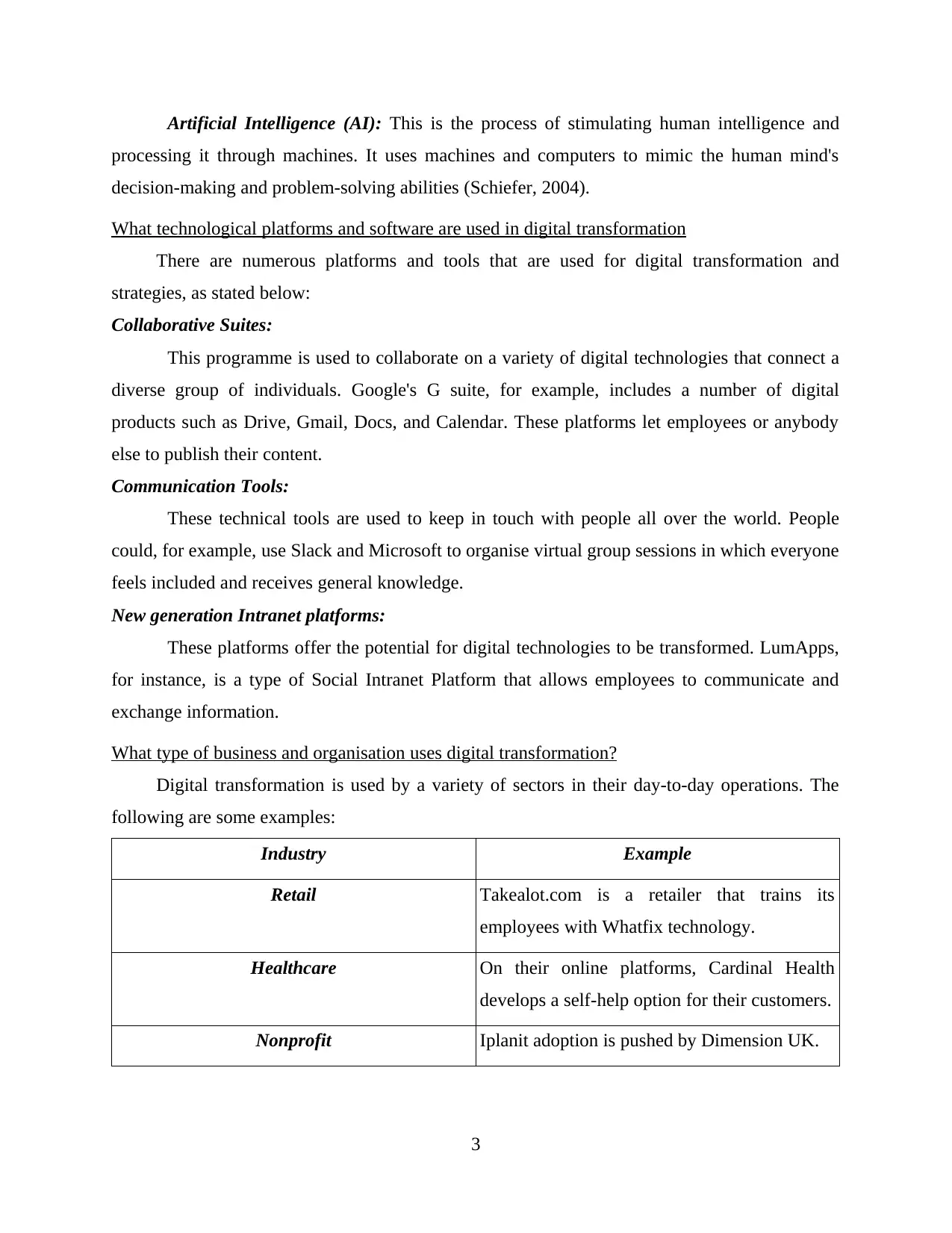
Artificial Intelligence (AI): This is the process of stimulating human intelligence and
processing it through machines. It uses machines and computers to mimic the human mind's
decision-making and problem-solving abilities (Schiefer, 2004).
What technological platforms and software are used in digital transformation
There are numerous platforms and tools that are used for digital transformation and
strategies, as stated below:
Collaborative Suites:
This programme is used to collaborate on a variety of digital technologies that connect a
diverse group of individuals. Google's G suite, for example, includes a number of digital
products such as Drive, Gmail, Docs, and Calendar. These platforms let employees or anybody
else to publish their content.
Communication Tools:
These technical tools are used to keep in touch with people all over the world. People
could, for example, use Slack and Microsoft to organise virtual group sessions in which everyone
feels included and receives general knowledge.
New generation Intranet platforms:
These platforms offer the potential for digital technologies to be transformed. LumApps,
for instance, is a type of Social Intranet Platform that allows employees to communicate and
exchange information.
What type of business and organisation uses digital transformation?
Digital transformation is used by a variety of sectors in their day-to-day operations. The
following are some examples:
Industry Example
Retail Takealot.com is a retailer that trains its
employees with Whatfix technology.
Healthcare On their online platforms, Cardinal Health
develops a self-help option for their customers.
Nonprofit Iplanit adoption is pushed by Dimension UK.
3
processing it through machines. It uses machines and computers to mimic the human mind's
decision-making and problem-solving abilities (Schiefer, 2004).
What technological platforms and software are used in digital transformation
There are numerous platforms and tools that are used for digital transformation and
strategies, as stated below:
Collaborative Suites:
This programme is used to collaborate on a variety of digital technologies that connect a
diverse group of individuals. Google's G suite, for example, includes a number of digital
products such as Drive, Gmail, Docs, and Calendar. These platforms let employees or anybody
else to publish their content.
Communication Tools:
These technical tools are used to keep in touch with people all over the world. People
could, for example, use Slack and Microsoft to organise virtual group sessions in which everyone
feels included and receives general knowledge.
New generation Intranet platforms:
These platforms offer the potential for digital technologies to be transformed. LumApps,
for instance, is a type of Social Intranet Platform that allows employees to communicate and
exchange information.
What type of business and organisation uses digital transformation?
Digital transformation is used by a variety of sectors in their day-to-day operations. The
following are some examples:
Industry Example
Retail Takealot.com is a retailer that trains its
employees with Whatfix technology.
Healthcare On their online platforms, Cardinal Health
develops a self-help option for their customers.
Nonprofit Iplanit adoption is pushed by Dimension UK.
3
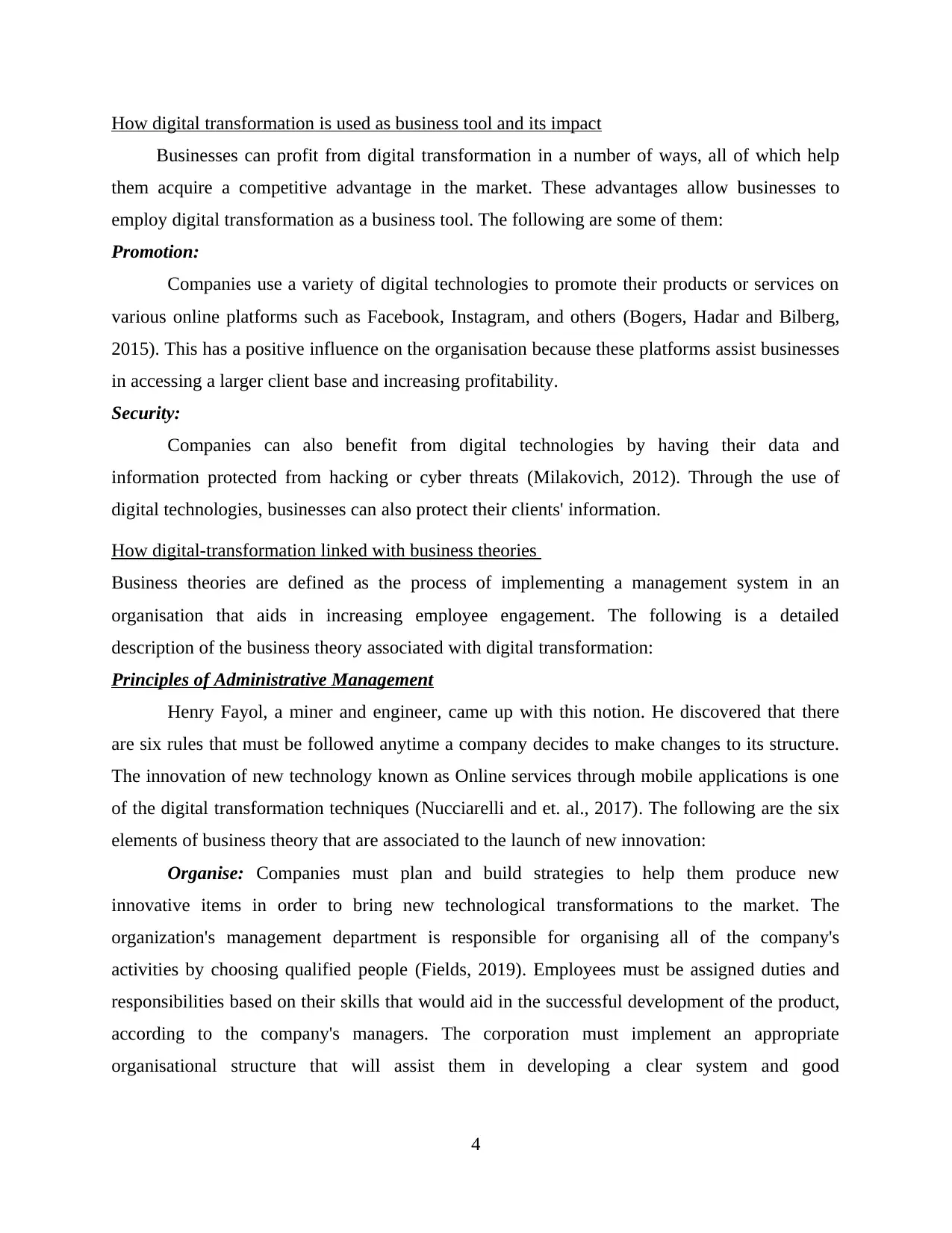
How digital transformation is used as business tool and its impact
Businesses can profit from digital transformation in a number of ways, all of which help
them acquire a competitive advantage in the market. These advantages allow businesses to
employ digital transformation as a business tool. The following are some of them:
Promotion:
Companies use a variety of digital technologies to promote their products or services on
various online platforms such as Facebook, Instagram, and others (Bogers, Hadar and Bilberg,
2015). This has a positive influence on the organisation because these platforms assist businesses
in accessing a larger client base and increasing profitability.
Security:
Companies can also benefit from digital technologies by having their data and
information protected from hacking or cyber threats (Milakovich, 2012). Through the use of
digital technologies, businesses can also protect their clients' information.
How digital-transformation linked with business theories
Business theories are defined as the process of implementing a management system in an
organisation that aids in increasing employee engagement. The following is a detailed
description of the business theory associated with digital transformation:
Principles of Administrative Management
Henry Fayol, a miner and engineer, came up with this notion. He discovered that there
are six rules that must be followed anytime a company decides to make changes to its structure.
The innovation of new technology known as Online services through mobile applications is one
of the digital transformation techniques (Nucciarelli and et. al., 2017). The following are the six
elements of business theory that are associated to the launch of new innovation:
Organise: Companies must plan and build strategies to help them produce new
innovative items in order to bring new technological transformations to the market. The
organization's management department is responsible for organising all of the company's
activities by choosing qualified people (Fields, 2019). Employees must be assigned duties and
responsibilities based on their skills that would aid in the successful development of the product,
according to the company's managers. The corporation must implement an appropriate
organisational structure that will assist them in developing a clear system and good
4
Businesses can profit from digital transformation in a number of ways, all of which help
them acquire a competitive advantage in the market. These advantages allow businesses to
employ digital transformation as a business tool. The following are some of them:
Promotion:
Companies use a variety of digital technologies to promote their products or services on
various online platforms such as Facebook, Instagram, and others (Bogers, Hadar and Bilberg,
2015). This has a positive influence on the organisation because these platforms assist businesses
in accessing a larger client base and increasing profitability.
Security:
Companies can also benefit from digital technologies by having their data and
information protected from hacking or cyber threats (Milakovich, 2012). Through the use of
digital technologies, businesses can also protect their clients' information.
How digital-transformation linked with business theories
Business theories are defined as the process of implementing a management system in an
organisation that aids in increasing employee engagement. The following is a detailed
description of the business theory associated with digital transformation:
Principles of Administrative Management
Henry Fayol, a miner and engineer, came up with this notion. He discovered that there
are six rules that must be followed anytime a company decides to make changes to its structure.
The innovation of new technology known as Online services through mobile applications is one
of the digital transformation techniques (Nucciarelli and et. al., 2017). The following are the six
elements of business theory that are associated to the launch of new innovation:
Organise: Companies must plan and build strategies to help them produce new
innovative items in order to bring new technological transformations to the market. The
organization's management department is responsible for organising all of the company's
activities by choosing qualified people (Fields, 2019). Employees must be assigned duties and
responsibilities based on their skills that would aid in the successful development of the product,
according to the company's managers. The corporation must implement an appropriate
organisational structure that will assist them in developing a clear system and good
4
⊘ This is a preview!⊘
Do you want full access?
Subscribe today to unlock all pages.

Trusted by 1+ million students worldwide
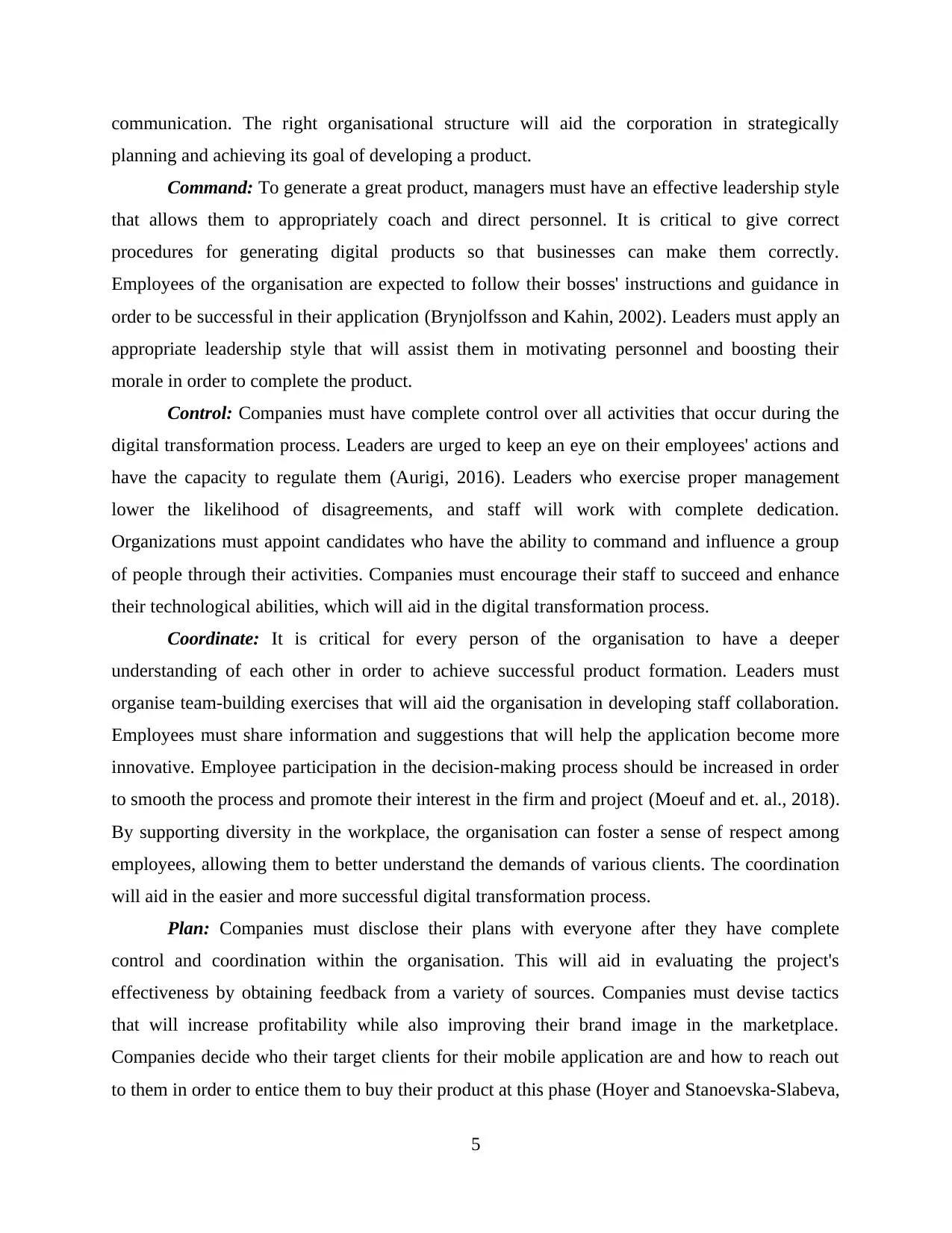
communication. The right organisational structure will aid the corporation in strategically
planning and achieving its goal of developing a product.
Command: To generate a great product, managers must have an effective leadership style
that allows them to appropriately coach and direct personnel. It is critical to give correct
procedures for generating digital products so that businesses can make them correctly.
Employees of the organisation are expected to follow their bosses' instructions and guidance in
order to be successful in their application (Brynjolfsson and Kahin, 2002). Leaders must apply an
appropriate leadership style that will assist them in motivating personnel and boosting their
morale in order to complete the product.
Control: Companies must have complete control over all activities that occur during the
digital transformation process. Leaders are urged to keep an eye on their employees' actions and
have the capacity to regulate them (Aurigi, 2016). Leaders who exercise proper management
lower the likelihood of disagreements, and staff will work with complete dedication.
Organizations must appoint candidates who have the ability to command and influence a group
of people through their activities. Companies must encourage their staff to succeed and enhance
their technological abilities, which will aid in the digital transformation process.
Coordinate: It is critical for every person of the organisation to have a deeper
understanding of each other in order to achieve successful product formation. Leaders must
organise team-building exercises that will aid the organisation in developing staff collaboration.
Employees must share information and suggestions that will help the application become more
innovative. Employee participation in the decision-making process should be increased in order
to smooth the process and promote their interest in the firm and project (Moeuf and et. al., 2018).
By supporting diversity in the workplace, the organisation can foster a sense of respect among
employees, allowing them to better understand the demands of various clients. The coordination
will aid in the easier and more successful digital transformation process.
Plan: Companies must disclose their plans with everyone after they have complete
control and coordination within the organisation. This will aid in evaluating the project's
effectiveness by obtaining feedback from a variety of sources. Companies must devise tactics
that will increase profitability while also improving their brand image in the marketplace.
Companies decide who their target clients for their mobile application are and how to reach out
to them in order to entice them to buy their product at this phase (Hoyer and Stanoevska-Slabeva,
5
planning and achieving its goal of developing a product.
Command: To generate a great product, managers must have an effective leadership style
that allows them to appropriately coach and direct personnel. It is critical to give correct
procedures for generating digital products so that businesses can make them correctly.
Employees of the organisation are expected to follow their bosses' instructions and guidance in
order to be successful in their application (Brynjolfsson and Kahin, 2002). Leaders must apply an
appropriate leadership style that will assist them in motivating personnel and boosting their
morale in order to complete the product.
Control: Companies must have complete control over all activities that occur during the
digital transformation process. Leaders are urged to keep an eye on their employees' actions and
have the capacity to regulate them (Aurigi, 2016). Leaders who exercise proper management
lower the likelihood of disagreements, and staff will work with complete dedication.
Organizations must appoint candidates who have the ability to command and influence a group
of people through their activities. Companies must encourage their staff to succeed and enhance
their technological abilities, which will aid in the digital transformation process.
Coordinate: It is critical for every person of the organisation to have a deeper
understanding of each other in order to achieve successful product formation. Leaders must
organise team-building exercises that will aid the organisation in developing staff collaboration.
Employees must share information and suggestions that will help the application become more
innovative. Employee participation in the decision-making process should be increased in order
to smooth the process and promote their interest in the firm and project (Moeuf and et. al., 2018).
By supporting diversity in the workplace, the organisation can foster a sense of respect among
employees, allowing them to better understand the demands of various clients. The coordination
will aid in the easier and more successful digital transformation process.
Plan: Companies must disclose their plans with everyone after they have complete
control and coordination within the organisation. This will aid in evaluating the project's
effectiveness by obtaining feedback from a variety of sources. Companies must devise tactics
that will increase profitability while also improving their brand image in the marketplace.
Companies decide who their target clients for their mobile application are and how to reach out
to them in order to entice them to buy their product at this phase (Hoyer and Stanoevska-Slabeva,
5
Paraphrase This Document
Need a fresh take? Get an instant paraphrase of this document with our AI Paraphraser
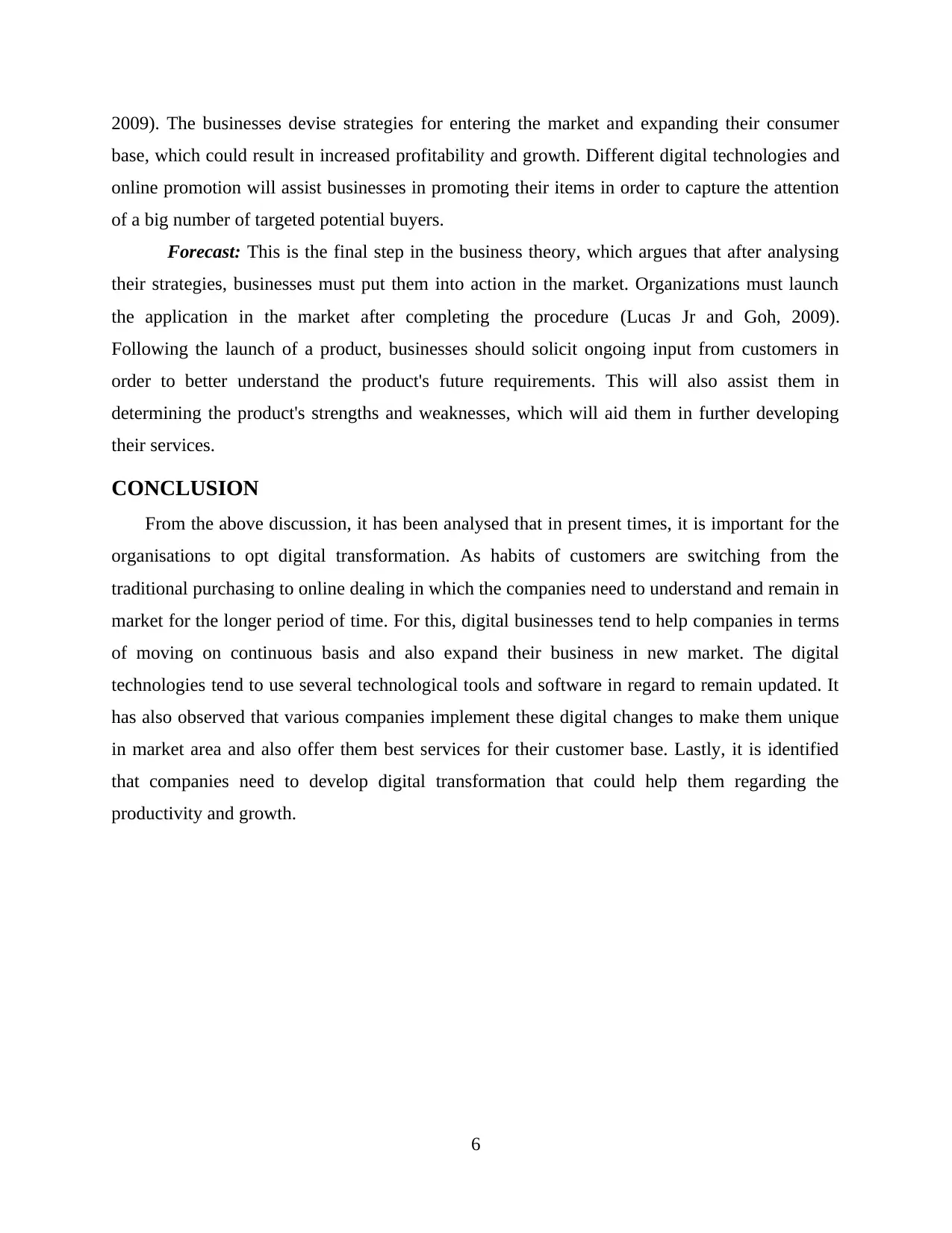
2009). The businesses devise strategies for entering the market and expanding their consumer
base, which could result in increased profitability and growth. Different digital technologies and
online promotion will assist businesses in promoting their items in order to capture the attention
of a big number of targeted potential buyers.
Forecast: This is the final step in the business theory, which argues that after analysing
their strategies, businesses must put them into action in the market. Organizations must launch
the application in the market after completing the procedure (Lucas Jr and Goh, 2009).
Following the launch of a product, businesses should solicit ongoing input from customers in
order to better understand the product's future requirements. This will also assist them in
determining the product's strengths and weaknesses, which will aid them in further developing
their services.
CONCLUSION
From the above discussion, it has been analysed that in present times, it is important for the
organisations to opt digital transformation. As habits of customers are switching from the
traditional purchasing to online dealing in which the companies need to understand and remain in
market for the longer period of time. For this, digital businesses tend to help companies in terms
of moving on continuous basis and also expand their business in new market. The digital
technologies tend to use several technological tools and software in regard to remain updated. It
has also observed that various companies implement these digital changes to make them unique
in market area and also offer them best services for their customer base. Lastly, it is identified
that companies need to develop digital transformation that could help them regarding the
productivity and growth.
6
base, which could result in increased profitability and growth. Different digital technologies and
online promotion will assist businesses in promoting their items in order to capture the attention
of a big number of targeted potential buyers.
Forecast: This is the final step in the business theory, which argues that after analysing
their strategies, businesses must put them into action in the market. Organizations must launch
the application in the market after completing the procedure (Lucas Jr and Goh, 2009).
Following the launch of a product, businesses should solicit ongoing input from customers in
order to better understand the product's future requirements. This will also assist them in
determining the product's strengths and weaknesses, which will aid them in further developing
their services.
CONCLUSION
From the above discussion, it has been analysed that in present times, it is important for the
organisations to opt digital transformation. As habits of customers are switching from the
traditional purchasing to online dealing in which the companies need to understand and remain in
market for the longer period of time. For this, digital businesses tend to help companies in terms
of moving on continuous basis and also expand their business in new market. The digital
technologies tend to use several technological tools and software in regard to remain updated. It
has also observed that various companies implement these digital changes to make them unique
in market area and also offer them best services for their customer base. Lastly, it is identified
that companies need to develop digital transformation that could help them regarding the
productivity and growth.
6
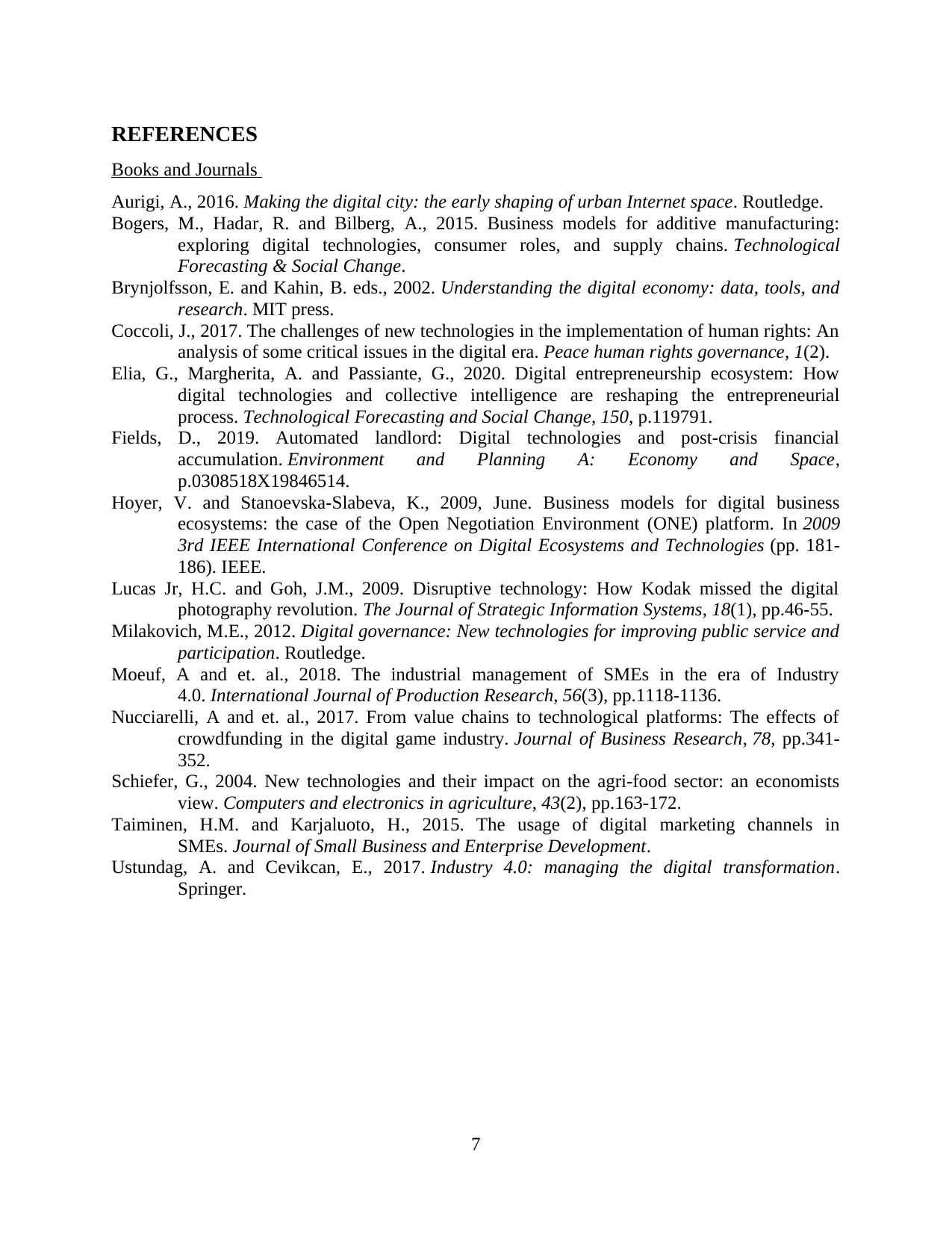
REFERENCES
Books and Journals
Aurigi, A., 2016. Making the digital city: the early shaping of urban Internet space. Routledge.
Bogers, M., Hadar, R. and Bilberg, A., 2015. Business models for additive manufacturing:
exploring digital technologies, consumer roles, and supply chains. Technological
Forecasting & Social Change.
Brynjolfsson, E. and Kahin, B. eds., 2002. Understanding the digital economy: data, tools, and
research. MIT press.
Coccoli, J., 2017. The challenges of new technologies in the implementation of human rights: An
analysis of some critical issues in the digital era. Peace human rights governance, 1(2).
Elia, G., Margherita, A. and Passiante, G., 2020. Digital entrepreneurship ecosystem: How
digital technologies and collective intelligence are reshaping the entrepreneurial
process. Technological Forecasting and Social Change, 150, p.119791.
Fields, D., 2019. Automated landlord: Digital technologies and post-crisis financial
accumulation. Environment and Planning A: Economy and Space,
p.0308518X19846514.
Hoyer, V. and Stanoevska-Slabeva, K., 2009, June. Business models for digital business
ecosystems: the case of the Open Negotiation Environment (ONE) platform. In 2009
3rd IEEE International Conference on Digital Ecosystems and Technologies (pp. 181-
186). IEEE.
Lucas Jr, H.C. and Goh, J.M., 2009. Disruptive technology: How Kodak missed the digital
photography revolution. The Journal of Strategic Information Systems, 18(1), pp.46-55.
Milakovich, M.E., 2012. Digital governance: New technologies for improving public service and
participation. Routledge.
Moeuf, A and et. al., 2018. The industrial management of SMEs in the era of Industry
4.0. International Journal of Production Research, 56(3), pp.1118-1136.
Nucciarelli, A and et. al., 2017. From value chains to technological platforms: The effects of
crowdfunding in the digital game industry. Journal of Business Research, 78, pp.341-
352.
Schiefer, G., 2004. New technologies and their impact on the agri-food sector: an economists
view. Computers and electronics in agriculture, 43(2), pp.163-172.
Taiminen, H.M. and Karjaluoto, H., 2015. The usage of digital marketing channels in
SMEs. Journal of Small Business and Enterprise Development.
Ustundag, A. and Cevikcan, E., 2017. Industry 4.0: managing the digital transformation.
Springer.
7
Books and Journals
Aurigi, A., 2016. Making the digital city: the early shaping of urban Internet space. Routledge.
Bogers, M., Hadar, R. and Bilberg, A., 2015. Business models for additive manufacturing:
exploring digital technologies, consumer roles, and supply chains. Technological
Forecasting & Social Change.
Brynjolfsson, E. and Kahin, B. eds., 2002. Understanding the digital economy: data, tools, and
research. MIT press.
Coccoli, J., 2017. The challenges of new technologies in the implementation of human rights: An
analysis of some critical issues in the digital era. Peace human rights governance, 1(2).
Elia, G., Margherita, A. and Passiante, G., 2020. Digital entrepreneurship ecosystem: How
digital technologies and collective intelligence are reshaping the entrepreneurial
process. Technological Forecasting and Social Change, 150, p.119791.
Fields, D., 2019. Automated landlord: Digital technologies and post-crisis financial
accumulation. Environment and Planning A: Economy and Space,
p.0308518X19846514.
Hoyer, V. and Stanoevska-Slabeva, K., 2009, June. Business models for digital business
ecosystems: the case of the Open Negotiation Environment (ONE) platform. In 2009
3rd IEEE International Conference on Digital Ecosystems and Technologies (pp. 181-
186). IEEE.
Lucas Jr, H.C. and Goh, J.M., 2009. Disruptive technology: How Kodak missed the digital
photography revolution. The Journal of Strategic Information Systems, 18(1), pp.46-55.
Milakovich, M.E., 2012. Digital governance: New technologies for improving public service and
participation. Routledge.
Moeuf, A and et. al., 2018. The industrial management of SMEs in the era of Industry
4.0. International Journal of Production Research, 56(3), pp.1118-1136.
Nucciarelli, A and et. al., 2017. From value chains to technological platforms: The effects of
crowdfunding in the digital game industry. Journal of Business Research, 78, pp.341-
352.
Schiefer, G., 2004. New technologies and their impact on the agri-food sector: an economists
view. Computers and electronics in agriculture, 43(2), pp.163-172.
Taiminen, H.M. and Karjaluoto, H., 2015. The usage of digital marketing channels in
SMEs. Journal of Small Business and Enterprise Development.
Ustundag, A. and Cevikcan, E., 2017. Industry 4.0: managing the digital transformation.
Springer.
7
⊘ This is a preview!⊘
Do you want full access?
Subscribe today to unlock all pages.

Trusted by 1+ million students worldwide
1 out of 9
Related Documents
Your All-in-One AI-Powered Toolkit for Academic Success.
+13062052269
info@desklib.com
Available 24*7 on WhatsApp / Email
![[object Object]](/_next/static/media/star-bottom.7253800d.svg)
Unlock your academic potential
Copyright © 2020–2025 A2Z Services. All Rights Reserved. Developed and managed by ZUCOL.


